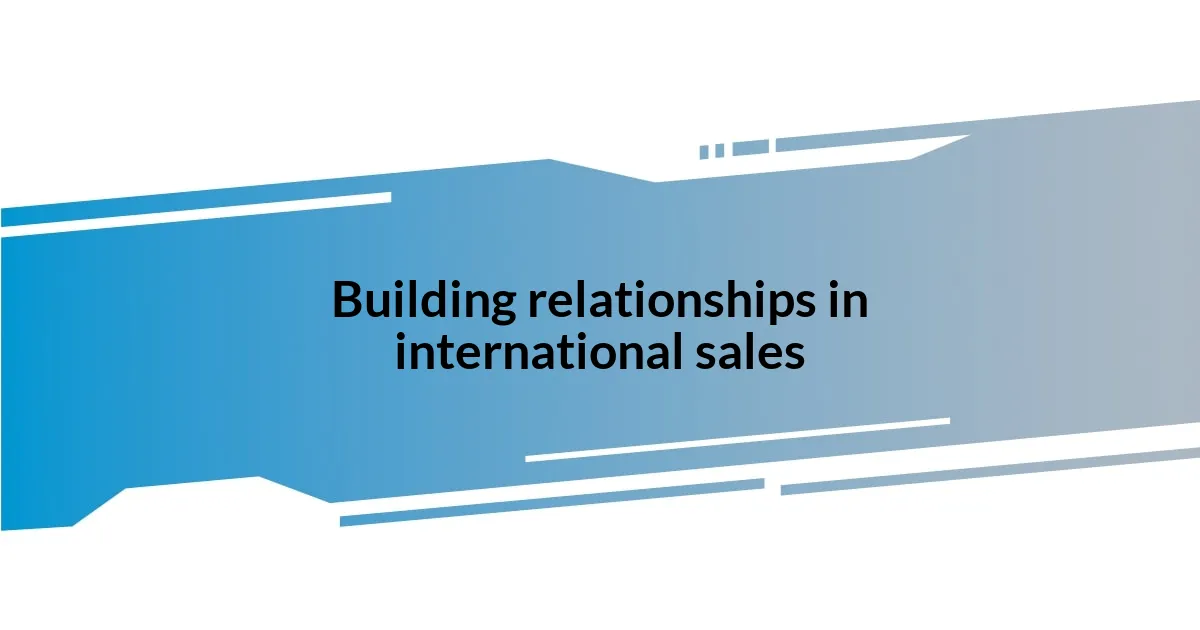Key takeaways:
- Recognizing cultural nuances and buying behaviors is crucial for adapting sales strategies in international markets.
- Building genuine relationships and understanding cultural differences can significantly enhance client trust and facilitate business negotiations.
- Strategic approaches like thorough market research, local partnerships, and continuous monitoring are essential for identifying opportunities in emerging markets.

Understanding international sales trends
Understanding international sales trends involves a keen awareness of cultural nuances and buying behaviors. For instance, during my time collaborating with a client in Southeast Asia, I noticed how local festivals significantly impacted purchasing patterns. Seeing how deeply culture intertwines with sales was an eye-opener for me—can you imagine the ripple effects on inventory management?
I’ve also observed that digital transformation plays a pivotal role in international markets. Recently, a friend of mine launched a product across Europe, relying heavily on e-commerce platforms. Watching her adapt her marketing strategies for different countries left me pondering—how can businesses better align their approaches with the fast-paced virtual landscape?
Another critical aspect is understanding regulatory environments, which can vary dramatically from one country to another. I remember being completely taken aback by the complexities of tariffs when I helped a startup enter the Canadian market. How often do we overlook the barriers that regulatory frameworks can present? This realization drives home the importance of thorough research and proactive strategizing in navigating international waters.

Identifying emerging markets opportunities
Identifying opportunities in emerging markets requires a nuanced approach. During my journey in international sales, I stumbled upon a fascinating opportunity in Sub-Saharan Africa. The rapid urbanization and growing middle class there presented a unique canvas for businesses to paint their strategies. I recall attending a local trade show and being struck by how eager the entrepreneurs were to connect with global partners. It was a reminder that, sometimes, the key to tapping into these markets lies in building real relationships and understanding local aspirations.
To effectively identify these opportunities, consider the following strategies:
- Market Research: Dig deep into demographics, trends, and consumer behaviors. I once spent weeks navigating reports and local insights before realizing the potential of a small niche market in South America.
- Networking: Attend industry events and engage with local businesses. It’s amazing how a simple conversation can unveil hidden opportunities.
- Local Partnerships: Collaborating with regional partners can provide invaluable insights. I learned this firsthand when teaming up with a local firm in Vietnam, which helped guide our entry strategy beautifully.
- Adaptation: Position your product or service to meet local needs. I remember tweaking our marketing messaging for a mid-range product, resulting in unexpected popularity among young professionals.
- Continuous Monitoring: Stay attuned to changing dynamics in these markets. I’ve found that regular check-ins can reveal shifts that point to new opportunities.

Building relationships in international sales
Building strong relationships in international sales is paramount, and I can’t stress enough how genuinely connecting with clients can redefine your approach. I remember a time in Brazil when a simple lunch turned into a profound discussion about family values in business. The warmth they expressed made me realize that behind every deal, there’s a human story that shapes the way people do business. Have you ever considered how much rapport can influence decision-making?
Cultural understanding lays the groundwork for authenticity in these relationships. While working with a client from Germany, I learned that their straightforward communication style contrasted sharply with the more relationship-oriented approach I was accustomed to in Latin America. It was enlightening to adapt my style to foster trust. Sometimes, I wonder how many opportunities we miss simply because we don’t take the time to understand our counterparts’ perspectives fully.
Investing time in nurturing these connections is not merely a strategy but an emotional commitment. I recall a client in Japan who, after years of exchanging pleasantries, finally invited me to their home for tea. That experience opened doors I had never imagined, allowing for deeper discussions about their needs and values. How often do we underestimate the power of personal connections in a business setting? Understanding that can truly transform the dynamics of international sales.
